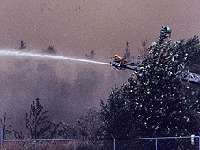|
Many local residents, especially those who lived in Delta, still remember the 1996 fire in Burns Bog. The fire spreaded very quickly. The fire sent a big plume of smoke that threatened air quality across the region. This picture showed one of the water bombers deployed to fight the fire.
The fire of 2005 also takes place in the northeast sector of the Bog, not
too far away from the fire of 96. The area is a fire hazard because it
is extremely dry. Peat harvesting on the east side of the Bog proved
to be environmentally devastating. The ditches that were put in to
drain large areas of the bog continue to dewater the wetland. Peat,
which is used in some countries as fossil fuels, is highly flammable.
Once the water level decreases, bog plants such as sphagnum mosses no longer
has an advantage over forest species. Pine trees grow very tall, and
salal move in. The forest species produce even more woody flammable
matter, thus further increasing the fire hazard.
According to Don DeMill, a bog specialist, the first thing to spring up after the natural disaster is
Bracken fern. Full forest conditions take some time. Once dewatering
happens, it is difficult to re-establish bog conditions. Forest litter
makes the soil nutrient rich. Even if the trees are removed, the nutrients
continue to feed weeds. Dikes have been put in to artificially raise water
levels but have been a failure.
|

|


|